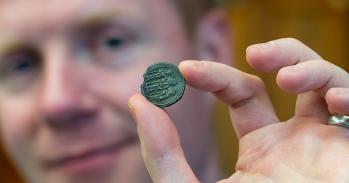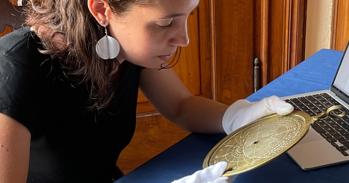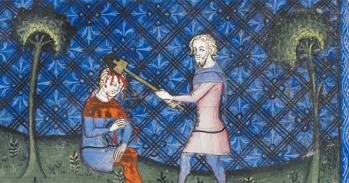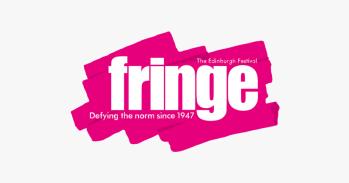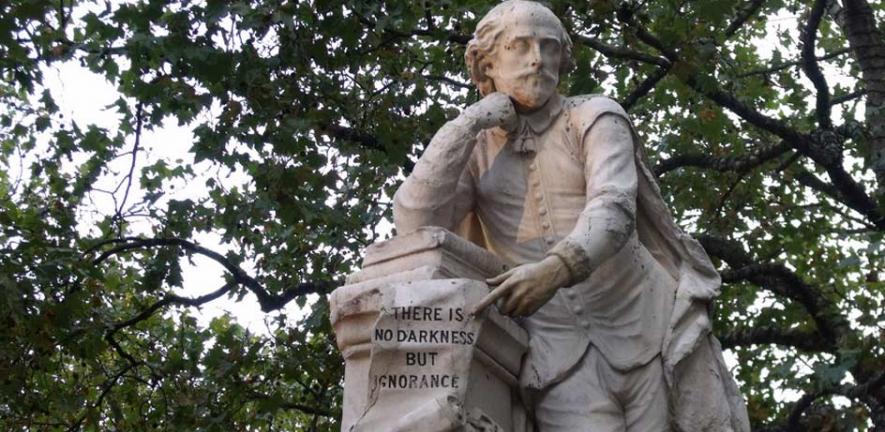
Medieval culture pervaded Shakespeare's life and work. Professor Helen Cooper examines its influence on the work of the world's greatest playwright.
Medieval culture pervaded Shakespeare's life and work. Professor Helen Cooper examines its influence on the work of the world's greatest playwright.
Although we think of Shakespeare as quintessentially belonging to the English Renaissance, his world was still largely a medieval one.
Professor Helen Cooper
A number of universities have chairs in early modern literature, a few in Middle English; Cambridge is unusual in combining the two, in the Chair of Medieval and Renaissance English originally set up for C.S. Lewis. His example of working across the periods has been followed by many of its later occupants, even though most scholars are cautious about crossing the invisible boundary between them. As the current holder of the Chair, I was delighted to be commissioned to write a book on Shakespeare and the Medieval World. Although we think of Shakespeare as quintessentially belonging to the English Renaissance, his world was still largely a medieval one.
Subtle glimpses of a changing time
Research is most often a process of discovering what’s there. That may be achieved by new technology, from Galileo’s telescope to the electron microscope, or simply by looking at things from a new angle or seeing them differently. Shakespeare’s medieval world is of the second kind.
We have, for instance, a number of early 17th-century engravings of London that are regularly reproduced in histories of the early modern city or books on Elizabethan drama. Apart from the newly-built theatres on the south bank, however, almost everything in the pictures is medieval: the great hulk of old St Paul’s towering over the city, the serrated skyline of the towers and spires of the parish churches, the bridge (completed in 1209) with its display of traitors’ heads, William the Conqueror’s Tower. They show, in fact, not so much ‘Shakespeare’s London’ as ‘Medieval London in the age of Shakespeare’.
Staging the world
The same principles apply to drama. Many of the great cycles of Biblical mystery plays, which we think of as medieval, continued to be performed until half-way through Queen Elizabeth’s reign, a couple of them (both now lost) into the reign of King James I. Coventry, not far from Stratford, had one of the best known; it was last performed in 1579, when Shakespeare was 14 years old. His plays contain a number of allusions to the cycle plays – ‘out-Heroding Herod’ is the most famous of them – and most of them bear a particularly close relationship to what is known of the Coventry cycle. It can’t be proved that he saw it, but of the many unknowns in his life, that he did so is one of the safer conjectures.
The cycle plays, furthermore, offered a model of theatre that was at the opposite extreme from the Classical Latin drama that was taught in the schools and imitated by humanist playwrights. It was insistently inclusive. The motto traditionally ascribed to the Globe, ‘Totus mundus agit histrionem’ (something between ‘all the world’s a stage’ and ‘everyone acts a part’), declared that the theatre was as large as the world: the maxim first appears in the 12th-century writer John of Salisbury, whose works were regularly reprinted in the Renaissance and were known, among others, to Ben Jonson.
The theorists might insist that kings and clowns should never share a stage, but it was the very point of the Biblical plays that both kings and shepherds came to the newborn Christ. They did not separate out comedy and tragedy, both newly-imported terms: they offered an all-embracing play, in which black humour and deep grief could mix in the Passion sequences. They had no qualms about presenting a vast range of time and space on stage, from the Fall of the Angels to the Last Judgement, in ways that can make Shakespeare’s embrace of Rome and Egypt within a single play, or a time span that allows for babies to grow to adulthood, seem quite modest. And above all, they acted their action. Classical and humanist drama relied on messengers to report what was happening outside the single location it allowed itself, and especially any kind of violence. Medieval and Shakespearean drama performed it, blood and all.
Those ideas are so familiar now – so much part of what plays do – that it is easy to forget how much they needed to be asserted. Some, such as the mixing of tragedy and comedy, incited bitter hostility among Elizabethan theorists and have continued to cause unease for much longer (hence the notion of ‘comic relief’: it’s more complicated, and more profound, than that). The dramatists for the public theatres, like their medieval forebears, assumed that the stage had the same freedom of representation that we now accord to the cinema screen. No one expects the screen to obey the Aristotelean principles for the stage rediscovered around 1500 – that it should show only one place, or that the action shown on it should approximate to real time; both are possible, but exceptional. Medieval principles of theatre gave Shakespeare and his fellow playwrights the freedom that the neo-Classicists wanted to forbid.
What Shakespeare read
‘Medieval Shakespeare’ extends not just to his theatre, but to his reading, and to what he wrote about. Not only his plays on English history, but Macbeth, Hamlet and Lear draw on history or legendary history as it was carried forward from the Middle Ages.
The story of Hamlet was first written down around 1200, and was in oral tradition before that. Lear was invented by Geoffrey of Monmouth in his History of the Kings of Britain(c. 1136), and Holinshed’s great Chronicles, the Elizabethans’ encylopaedic history of their real and supposed past, took the story from there. Lear’s Tom o’ Bedlam quotes from a folktale, and from one of the medieval verse romances that in cheap print provided the 16th century with much of its pulp fiction. The Trojan Troilus and Cressida draws on Chaucer and Caxton much more than on Homer; Chaucer is the sole source for The Two Noble Kinsmen, a collaboration with John Fletcher, and is the major inspiration for A Midsummer Night’s Dream. Chaucer’s contemporary John Gower, whose tomb faces the grave of Shakespeare’s brother in what was once the parish church for the Globe and is now Southwark Cathedral, is both the source for the story of Pericles and appears on stage as its presenter. Around half of Shakespeare’s plays have direct or indirect medieval sources, and they are a minor presence in many more.
None of this means that Shakespeare was a medieval writer: he changed everything he touched, whether inherited or new. But it is only possible to measure what he achieved, or even to see it clearly, when we recognise how much the Middle Ages gave the world’s greatest playwright to work on.
For more information, contact Professor Helen Cooper (ehc31@cam.ac.uk) at the Faculty of English or Magdalene College.
This work is licensed under a Creative Commons Licence. If you use this content on your site please link back to this page.


